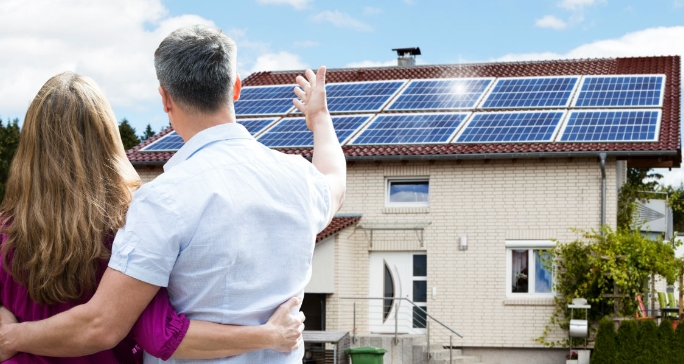
1. Understanding Solar Roof Tiles
Solar roof tiles combine the functions of traditional roofing materials with solar energy collection, offering a dual-purpose solution. Unlike conventional solar panels, which are mounted on top of existing roofing, solar roof tiles replace standard roof materials. They come in a variety of styles that mimic traditional shingles, slate, or even clay tiles, allowing for a more aesthetically pleasing look.
2. Initial Costs: Installation and Materials
The upfront cost of solar roof tiles is typically higher than traditional solar panels, primarily due to the need for them to function both as roofing material and as an energy source. On average, homeowners can expect to pay between $20 to $30 per square foot for solar roof tiles. This price includes both the tiles and their installation, though prices can vary based on factors such as:
- Roof size: A larger roof will naturally require more tiles and, therefore, higher costs.
- Roof complexity: Roofs with multiple slopes, dormers, or chimneys can require more labor and customization, increasing installation costs.
- Material choices: Some solar tiles are designed to look like luxury materials, such as terracotta or slate, which can drive up the price compared to simpler designs.
For a typical home, the total cost of installing solar roof tiles can range from $30,000 to $50,000. However, for larger homes or more complex installations, the cost can exceed $70,000.
3. Comparing Solar Tiles to Traditional Solar Panels
While solar roof tiles offer an elegant and seamless aesthetic, they are typically more expensive than traditional solar panels. Traditional solar panels cost around $2.50 to $3.50 per watt, with the average system for a standard-sized home ranging between $15,000 and $25,000. This makes traditional panels more cost-effective if the primary goal is energy savings over appearance.
4. Long-Term Savings and Energy Production
One of the key benefits of solar roof tiles is their ability to generate electricity, which can lead to significant savings on energy bills. The exact amount saved depends on factors like:
- Geographic location: Homes in sunnier areas will generate more energy from their solar tiles.
- Energy consumption: Homes with higher energy usage can benefit more from solar energy generation.
- Utility rates: In areas with high electricity rates, the savings from solar roof tiles can be more substantial.
Over the lifespan of solar roof tiles, which is generally around 25-30 years, homeowners can save tens of thousands of dollars in energy costs. However, the payback period (the time it takes for the energy savings to cover the cost of installation) typically ranges between 15 and 25 years, depending on these factors.
5. Government Incentives and Rebates
Homeowners can offset the high initial cost of solar roof tiles through various federal, state, and local incentives. The Federal Solar Investment Tax Credit (ITC), for instance, allows homeowners to deduct 30% of the installation cost from their federal taxes. Some states and municipalities offer additional rebates or incentives, further reducing the overall cost.
It’s important to research available incentives in your area before committing to a solar roof project, as they can significantly impact the overall financial picture.
6. Maintenance and Durability
Solar roof tiles are generally low-maintenance, similar to traditional roofing materials. They are built to withstand harsh weather conditions, including hail and high winds. However, if individual tiles are damaged, repairs can be more costly and complex compared to standard roofing materials or traditional solar panels. In many cases, you’ll need to hire a professional who specializes in solar tile systems to ensure the repairs don’t impact energy production.
7. Resale Value and Aesthetic Appeal
Solar roof tiles can increase your home’s resale value by making it more energy-efficient and appealing to eco-conscious buyers. A well-designed solar roof can enhance the overall look of your home while providing a functional benefit. Homes equipped with solar energy systems often sell faster and at higher prices than homes without them. This can be especially true in markets where green homes and sustainability are highly valued.
8. Is It Worth the Investment?
The decision to invest in solar roof tiles depends on several factors, including your budget, energy goals, and aesthetic preferences. While the upfront cost is higher than traditional solar panels, the sleek design and dual-purpose functionality of solar roof tiles make them an appealing option for homeowners who value aesthetics and long-term energy savings.
If your primary goal is to lower your energy bills at the lowest possible cost, traditional solar panels may be the more affordable choice. However, if you’re looking to combine a high-end aesthetic with renewable energy generation, solar roof tiles offer a unique and innovative solution that can increase your home’s value and curb appeal.
Conclusion
Solar roof tiles represent the future of sustainable home energy, offering homeowners a cutting-edge solution to generate clean power without compromising on design. While they come with a higher initial cost compared to traditional solar panels, the long-term energy savings, potential incentives, and increased property value can make them a worthwhile investment for many. Before making the switch, it's essential to weigh these factors and consider how solar roof tiles fit into your home improvement goals and energy needs.




